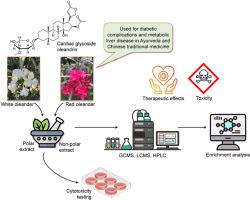夹竹桃的药物毒理学难题与植物化学成分的差异改变有关。
IF 2.4
4区 医学
Q2 PHARMACOLOGY & PHARMACY
引用次数: 0
摘要
夹竹桃在印度草药和中医中被用来治疗糖尿病和代谢性肝病。然而,它代表了循证医学中一个奇怪的悖论,因为尽管有一些临床前和临床毒理学报告,夹竹桃在传统医学中被广泛使用。我们假设夹竹桃的双重药理学活性是由于植物化学谱的变化。这种差异可能是由于夹竹桃品种(白色或红色)或溶剂提取过程。为了验证这一假设,我们从多个地理位置收集了两个夹竹桃品种的叶子,以消除由于环境和非生物因素造成的植物化学变化的可能性。采用气相色谱法和液相色谱法对夹竹桃极性提取物和非极性提取物进行了植物化学分析。采用高效液相色谱法测定夹竹桃苷含量。对非靶向代谢组学数据进行代谢物分类和代谢途径富集分析。用Caco-2和PBMC细胞比较细胞毒性。结果表明,植物化学成分受植物品种和溶剂提取技术的影响较大。红夹竹桃和甲醇提取物表明有毒夹竹桃素和脑素浓度升高。白夹竹桃中夹竹桃素含量较低,但生育酚和叶绿醇含量较高。甲醇提取物对Caco-2细胞和PBMCs的细胞毒性增强,与夹竹桃素浓度相关。不同提取物的代谢途径不同,如苯丙素的产生。综上所述,红夹竹桃的极性提取物由于夹竹桃素含量高而存在显著的毒性风险,而更安全的替代品是白夹竹桃的非极性提取物。本文章由计算机程序翻译,如有差异,请以英文原文为准。

Differentially altered phytochemical composition contributes to the pharmaco-toxicological conundrum of oleander
Nerium oleander L. is utilized in Ayurveda and Chinese traditional medicine to address diabetes and metabolic liver disease. However, oleander represents a bizarre paradox in evidence-based medicine since, despite several pre-clinical and clinical toxicological reports, oleander is extensively utilized in traditional medicine. We hypothesized that the dual pharmaco-toxicological activity of oleander is due to the variations in the phytochemical profile. This variance is likely due to the oleander variety (white or red) or the solvent extraction process. To test this hypothesis, leaves of both varieties of oleander were collected from multiple geographical locations to eliminate chances of phytochemical variation due to environmental and abiotic factors. Phytochemical profiling of polar and non-polar extracts of oleander was performed using GC-MS and LC-MS. Oleandrin content was measured using HPLC. Untargeted metabolomics data were subjected to metabolite class and metabolic pathway enrichment analysis. Comparative cytotoxicity was evaluated using Caco-2 and PBMC cells. Results showed that the phytochemical compositions are strongly influenced by the plant variety and solvent extraction technique. Red oleander and methanolic extracts demonstrated an elevated concentration of toxic oleandrin and cerebrin. While white oleander exhibited low levels of oleandrin, it contained higher levels of tocopherol and phytol. Methanol extracts exhibited enhanced cytotoxicity on Caco-2 cells and PBMCs, which correlated with oleandrin concentrations. Diverse metabolic pathways, such as phenylpropanoid production, differed among extracts. In conclusion, the polar extracts of red oleander present a significant risk of toxicity due to high oleandrin levels, and safer alternatives include non-polar extracts from white oleander.
求助全文
通过发布文献求助,成功后即可免费获取论文全文。
去求助
来源期刊

Toxicon
医学-毒理学
CiteScore
4.80
自引率
10.70%
发文量
358
审稿时长
68 days
期刊介绍:
Toxicon has an open access mirror Toxicon: X, sharing the same aims and scope, editorial team, submission system and rigorous peer review. An introductory offer Toxicon: X - full waiver of the Open Access fee.
Toxicon''s "aims and scope" are to publish:
-articles containing the results of original research on problems related to toxins derived from animals, plants and microorganisms
-papers on novel findings related to the chemical, pharmacological, toxicological, and immunological properties of natural toxins
-molecular biological studies of toxins and other genes from poisonous and venomous organisms that advance understanding of the role or function of toxins
-clinical observations on poisoning and envenoming where a new therapeutic principle has been proposed or a decidedly superior clinical result has been obtained.
-material on the use of toxins as tools in studying biological processes and material on subjects related to venom and antivenom problems.
-articles on the translational application of toxins, for example as drugs and insecticides
-epidemiological studies on envenoming or poisoning, so long as they highlight a previously unrecognised medical problem or provide insight into the prevention or medical treatment of envenoming or poisoning. Retrospective surveys of hospital records, especially those lacking species identification, will not be considered for publication. Properly designed prospective community-based surveys are strongly encouraged.
-articles describing well-known activities of venoms, such as antibacterial, anticancer, and analgesic activities of arachnid venoms, without any attempt to define the mechanism of action or purify the active component, will not be considered for publication in Toxicon.
-review articles on problems related to toxinology.
To encourage the exchange of ideas, sections of the journal may be devoted to Short Communications, Letters to the Editor and activities of the affiliated societies.
 求助内容:
求助内容: 应助结果提醒方式:
应助结果提醒方式:


